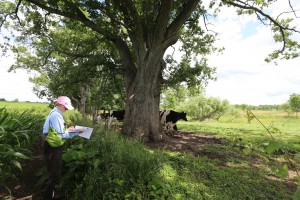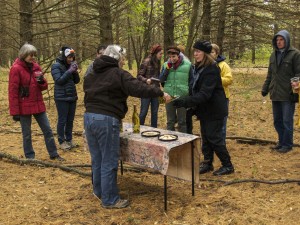by Susan Lackey, Executive Director
We had an interesting discussion in the office the other day about why we have a stewardship staff. The question wasn’t, “do we need their function?”, but rather, “why aren’t we all stewards of the land?” Good question. Don’t you just hate those?
 When we think about stewardship, we tend to think about the responsibilities we assume when the land is protected. Many of you know about our Forever Fund, which ensures that we will always have the financial resources to guarantee a visit to every protected property every year. In my words: make sure no one snuck a roller rink into the wetland. Each time we protect a property, we need to find another $7,000 for that fund.
When we think about stewardship, we tend to think about the responsibilities we assume when the land is protected. Many of you know about our Forever Fund, which ensures that we will always have the financial resources to guarantee a visit to every protected property every year. In my words: make sure no one snuck a roller rink into the wetland. Each time we protect a property, we need to find another $7,000 for that fund.
We also steward our six nature preserves. Increasingly, we don’t accept new preserves without a funding source for their ongoing care. In most cases, we actively manage these properties, removing invasive species, restoring native plants. At the very to make sure they are safe, attractive places for you to visit. Even though we rely heavily on Eco Steward volunteers, we plan their work, train them, and perform any work that requires special skills. All these things take time.
 Our third type of stewardship we hope connects you to the land. You may have attended a strolling wine-tasting at Sharon Hills or Beckwith, a full-moon solstice hike at the Lloyd and Mabel Johnson Preserve, or a Halloween storytelling at Reichert. During our 40th anniversary celebration (five years ago!) you might have joined us for five-hikes-in-five-days. During all these, you experienced our collective landscape, had some fun and, tucked in there someplace, learned a bit of botany, geology, herpetology or some other real knowledge. Because, of course, one of our hallmarks is that we believe when you’re outside, learning should be fun.
Our third type of stewardship we hope connects you to the land. You may have attended a strolling wine-tasting at Sharon Hills or Beckwith, a full-moon solstice hike at the Lloyd and Mabel Johnson Preserve, or a Halloween storytelling at Reichert. During our 40th anniversary celebration (five years ago!) you might have joined us for five-hikes-in-five-days. During all these, you experienced our collective landscape, had some fun and, tucked in there someplace, learned a bit of botany, geology, herpetology or some other real knowledge. Because, of course, one of our hallmarks is that we believe when you’re outside, learning should be fun.
Each of our nature preserves has a story to tell … about hardscrabble farming, early exploration, Native American commerce, glaciers and rocks, rare or common plants and animals, our connection to Great Lakes water quality. Those stories are why someone cared enough about the land to protect it forever, and why others were willing to provide the resources to do that.
In the context of human history and geological time those stories provide a deeper connection to the land, and to the people who have passed through it. For millennia, people have taken sustenance from what the land provided. The ways we’ve done that have varied over time, sometimes with the belief the land was inexhaustible, and other times, vividly aware of its fragility. Through those stories, that connection makes us better stewards not only of the land, but also of the communities in which we live today. It’s easier to be a good citizen when you carry a connection to place.
 Of course, the answer is that we are all stewards of the land; those who work here, the people who own the lands we protect, the people who give generously of their time and money to make sure Legacy’s work is sustainable. If I have learned anything from over a decade of daily education, that is the take-away. Knowing that, I know that Legacy, and the place to which I feel so connected, is in good hands. You will all be good stewards of this organization that does so much in this community.
Of course, the answer is that we are all stewards of the land; those who work here, the people who own the lands we protect, the people who give generously of their time and money to make sure Legacy’s work is sustainable. If I have learned anything from over a decade of daily education, that is the take-away. Knowing that, I know that Legacy, and the place to which I feel so connected, is in good hands. You will all be good stewards of this organization that does so much in this community.
This job has given me a new appreciation for the ongoing responsibility of stewarding place. I’ll never view a healthy forest or a clear-running stream in quite the same way again. Thank you for that.

 RSS Feed
RSS Feed